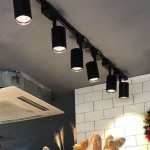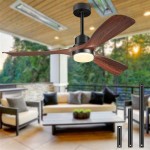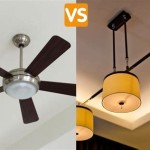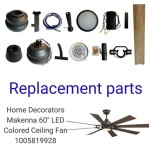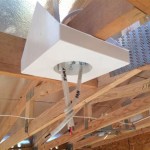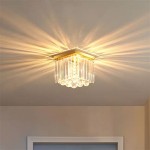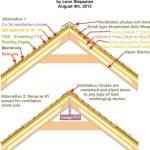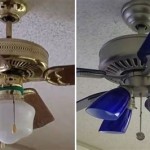Best Outdoor Ceiling Fans With Remote Control
Outdoor ceiling fans have become increasingly popular for patios, porches, and other outdoor living spaces. They provide a comfortable breeze, deter insects, and can even add a touch of style to the decor. The addition of a remote control enhances the convenience and functionality of these fans, allowing for easy adjustment of speed and light settings without having to get up. This article explores some of the best outdoor ceiling fans with remote control, considering factors such as durability, performance, features, and aesthetic appeal.
When selecting an outdoor ceiling fan, it's crucial to consider the environment in which it will be used. Fans designated as "outdoor" are specifically designed and constructed to withstand the elements. They often feature moisture-resistant motors, rust-proof finishes, and blades made from materials that won't warp or crack when exposed to humidity and sunlight. Many are UL listed for wet locations, which means they can be directly exposed to rain and snow. Others are UL listed for damp locations, indicating they are suitable for covered patios and porches where they are sheltered from direct precipitation.
The size of the outdoor space is another vital consideration when choosing a ceiling fan. Larger spaces will require fans with larger blade spans to effectively circulate air. A general guideline is to use a fan with a blade span of 44 inches or less for rooms up to 100 square feet, a 52-inch fan for rooms between 100 and 400 square feet, and a 60-inch or larger fan for spaces exceeding 400 square feet. The height of the ceiling should also be taken into account. For ceilings lower than eight feet, a hugger-style fan, which mounts flush to the ceiling, is often the best option. For higher ceilings, a downrod may be necessary to ensure the fan is positioned at the optimal height for air circulation, typically between seven and nine feet above the floor.
The availability of remote control functionality is a significant advantage. Remote controls offer convenient operation of the fan's speed and lighting. Most remote controls allow users to adjust the fan speed to multiple settings (low, medium, high), allowing for customized comfort levels. Many also have a reverse function, which allows the fan to be used in the winter to circulate warm air trapped near the ceiling. Models with integrated lighting often feature dimming capabilities, providing greater control over the ambiance of the outdoor space. Some advanced remote controls also include timer functions and learning capabilities, which allow the fan to be programmed to turn on and off at specific times.
Durability and Weather Resistance
The primary factor for selecting an outdoor ceiling fan is its ability to withstand the elements. Manufacturers use specific materials and construction techniques to ensure longevity in outdoor environments. Motors are often sealed to prevent moisture from damaging internal components. Finishes are designed to resist rust, corrosion, and fading. Blades are typically made from materials like ABS plastic, aluminum, or specially treated wood that are less susceptible to warping and cracking due to humidity and temperature fluctuations.
Fans with a UL (Underwriters Laboratories) listing for wet locations are designed to be directly exposed to rain and snow. These fans undergo rigorous testing to ensure they can safely operate in such conditions. Components, such as wiring and connections, are sealed to prevent water intrusion and electrical hazards. Fans with a UL listing for damp locations, on the other hand, are suitable for covered patios and porches where they are protected from direct precipitation.
When evaluating the durability of an outdoor ceiling fan, it's important to examine the materials used in its construction. For example, blades made from ABS plastic are known for their resistance to moisture and UV damage. Aluminum is another durable option that is lightweight and rust-resistant. Galvanized steel is often used for the fan's housing and downrod to prevent corrosion. Powder-coated finishes provide an extra layer of protection against the elements, ensuring the fan maintains its appearance for years to come.
Beyond the materials themselves, the quality of the construction is also crucial. Look for fans with tightly sealed seams and well-constructed joints to prevent water from entering the motor housing and other sensitive components. Check the warranty offered by the manufacturer. A longer warranty period typically indicates greater confidence in the product's durability and reliability. Reading customer reviews can also provide valuable insights into the fan's real-world performance and longevity.
Performance and Airflow Efficiency
An outdoor ceiling fan's performance is determined by its ability to effectively circulate air and provide a comfortable breeze. The fan's motor, blade pitch, and blade length all contribute to its airflow efficiency. A more powerful motor will generate more airflow, while a steeper blade pitch will move more air with each rotation. Longer blades will cover a larger area, making them suitable for larger outdoor spaces.
Airflow is typically measured in cubic feet per minute (CFM). A higher CFM rating indicates that the fan can move more air. When selecting an outdoor ceiling fan, it's important to choose a model with a CFM rating that is appropriate for the size of the space. For example, a small patio may only require a fan with a CFM rating of 3,000 to 4,000, while a larger deck may require a fan with a CFM rating of 5,000 or higher. It's also important to consider the height of the ceiling. Higher ceilings may require a fan with a stronger motor and steeper blade pitch to effectively circulate air down to the seating area.
The number of blades is another factor to consider. While the number of blades does not necessarily determine the fan's airflow, it can affect its appearance and noise level. Fans with fewer blades tend to be more efficient and quieter, while fans with more blades may provide a more subtle and consistent breeze. Ultimately, the best choice depends on personal preference and the specific needs of the outdoor space.
The motor's energy efficiency is also an important consideration, especially if the fan will be used frequently. Look for fans with ENERGY STAR certification, which indicates that they meet strict energy efficiency guidelines set by the U.S. Environmental Protection Agency. ENERGY STAR certified fans can save energy and reduce electricity bills compared to standard models. Additionally, consider fans with DC motors, which are generally more energy-efficient and quieter than AC motors.
Features and Remote Control Functionality
The features of an outdoor ceiling fan can significantly enhance its convenience and functionality. A remote control is a key feature that allows for easy adjustment of the fan's speed and lighting from a distance. Most remote controls offer multiple speed settings, allowing users to customize the airflow to their liking. Many also include a reverse function, which can be used in the winter to circulate warm air trapped near the ceiling. This can help to reduce heating costs and improve comfort levels.
Integrated lighting is another popular feature for outdoor ceiling fans. Many models come with built-in LED lights that provide ample illumination for outdoor spaces. LED lights are energy-efficient and long-lasting, making them a cost-effective lighting solution. Some fans also feature dimming capabilities, allowing users to adjust the brightness of the lights to create the desired ambiance. The ability to control the lighting with the remote control adds to the convenience of the fan.
Advanced remote controls may offer additional features such as timer functions and learning capabilities. Timer functions allow users to program the fan to turn on and off at specific times, which can be useful for energy conservation or security purposes. Learning capabilities allow the remote control to be programmed to operate multiple fans or other devices in the outdoor space. Some remote controls also feature smart home integration, allowing users to control the fan with their smartphone or voice assistants like Amazon Alexa or Google Assistant.
The range of the remote control is another important consideration. A remote control with a longer range will allow users to operate the fan from a greater distance. This can be particularly useful for larger outdoor spaces or when the fan is mounted in a hard-to-reach location. It's also important to consider the ease of use of the remote control. A remote control with large, clearly labeled buttons and a simple interface will be easier to operate, especially in low-light conditions.
When selecting an outdoor ceiling fan with remote control, it is advisable to test the remote control's responsiveness. Some low-quality remote controls may have a lag or require multiple presses to activate the fan. A high-quality remote control should respond quickly and reliably to user input.
Finally, aesthetic considerations will be a factor. An outdoor ceiling fan should complement the style of the outdoor space. Fans are available in a wide range of styles, from traditional to contemporary, and in a variety of finishes, such as bronze, nickel, and white. Choosing a fan that matches the existing decor will create a cohesive and visually appealing look.

Outdoor Ceiling Fans Wet Rated Covered Hunter Fan

The 11 Best Outdoor Ceiling Fans 2024 For Outdoors

The 11 Best Outdoor Ceiling Fans 2024 For Outdoors

Hunter Invector 60 In Indoor Outdoor Matte Black Ceiling Fan With Light And Remote Control 51407 The Home

Rainsford Outdoor 52 Inch Ceiling Fan Hunter

Aire By Minka Hillsdale 65 In Integrated Led Indoor Outdoor Coal Ceiling Fan With Light Kit And Remote Control 04755 The Home

9 Best Outdoor Ceiling Fans For The Patio Family Handyman

The 11 Best Outdoor Ceiling Fans 2024 For Outdoors

Best Outdoor Fans 2024 Forbes Vetted

Best Outdoor Ceiling Fans 2024 The Strategist
Related Posts
